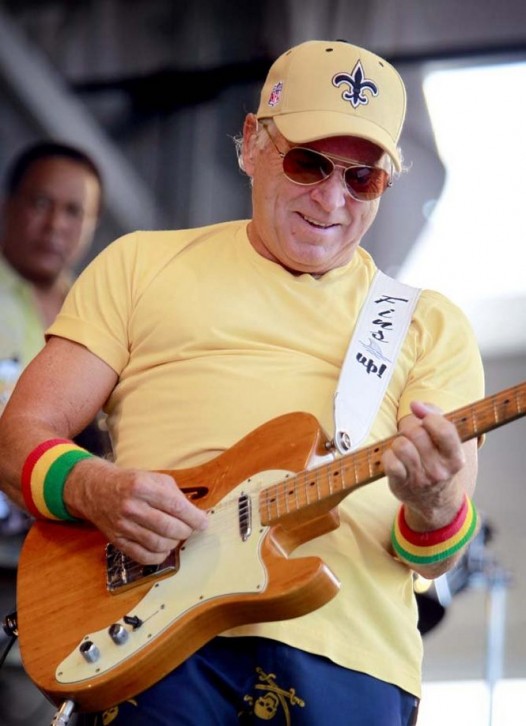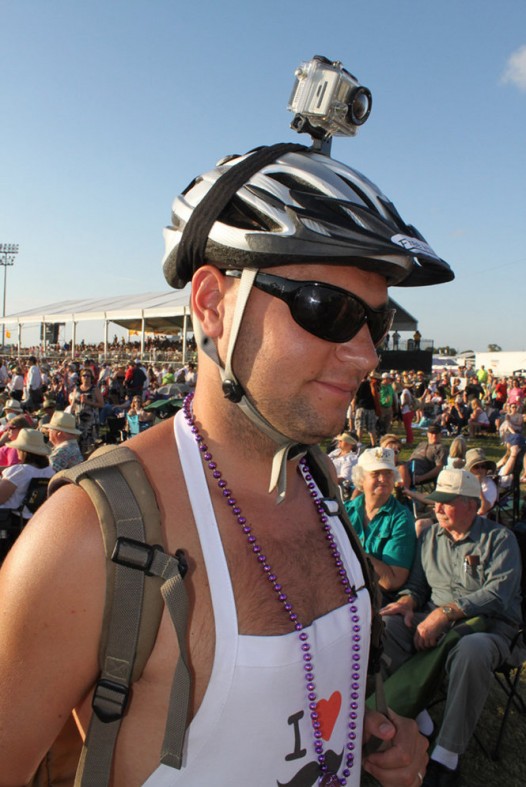Today I muse about … hats
There are many ways to analyze the various groups that will be flocking to the Fair Grounds come Thursday for the final weekend of The New Orleans Jazz and Heritage Festival. You can define them by age, by gender, by ethnicity, by geographic region, by musical – or even culinary – tastes.

Regular guy Jimmy Buffett, who plays Jazz Fest Thursday at 5:55 p.m. at the Acura Stage, makes an understatement with a baseball cap. (Nola.com photo)
But I think there’s something more tellingly anthropological in the kind of head gear they choose. To this end, I made a study last weekend of noggin toppings. Here are my completely unacademic findings and unresearched conclusions.
Hats at Jazz Fest fall into four broad categories, with each offering a telling commentary about the beings under the brims:
Baseball caps.
This most ubiquitous head covering spells Made in America, as the baseball cap, like baseball itself, is an indigenous species. But baseball caps, like bumper stickers, can carry personal and idiosyncratic messages, from one’s alma mater or birthplace to favored sports teams and bands.
People who wear baseball hats tend to be conformists, with fairly Catholic musical tastes and a tendency to avoid the alligator pie booth. Though baseball caps are rarely daring, they do connote people one can depend on.
If you need to borrow someone’s cell phone, opt for a baseball cap.
Straw hats.
They come in all shapes, colors and sizes, but straw hats uniformly say sun and fun. Straw hats come out when people are in party mode, so expect these wearers to be swaying on the grass to the beat of a tom tom. These are special-occasion toppers, not your jog-through-the-park headwear.
Straw hats run three-to-one female to male, although they certainly are unisex. The designer-end trend here is the Kabuki hat, which not only shouts fashionista, but also attests that you’re a Jazz Fest veteran.
If you’re inspired to pull a stranger into a waltz in front of the Fais Do-Do Stage, choose someone in a straw hat.
Safari hats.
The adventuresome and well-traveled among festers sport these rugged canvas numbers. With ties under the chin and brims curled, they attest to sophisticated tastes and a yen for the unfamiliar.
Safari hats skew male, but anyone who has seen The African Queen knows how devastatingly outré they can be on a gal. Safari hats tend to proliferate on mud days, and at offbeat musical offerings. Probably more Blues Tent than Acura Stage.
If you can’t decide whether or not the jama jama is worth the bucks, ask someone in a safari hat.
Cowboy hats.
Perhaps it’s the proximity of the Lone Star State that makes cowboy hats so frequently spotted at the Fair Grounds. One wonders whether, for instance, you’d see so many at Newport.
Still, this headpiece generally denotes a fester long on both personality and pocketbook. Think expansive. And this headliner needn’t lean toward country Western beats (which there’s a dearth of anyway at Jazz Fest). No, cowboy hats belong to the loners and leaders.
If you want to push through the crowd to the front of the Gentilly Stage, tuck in behind a cowboy hat.
Addendum one: Pins.
Any of the above categories gets polish and pizzazz with the addition of pins. Big pins, little pins, colorful pins, gold pins, silver pins, rhinestone pins.
The only rule: You gotta have a LOT of pins. One will just not do. The Jazz Fest crowd screams personality with a plethora of pins. Olympic Pins, festival pins, art pins … who knows where people get all of these pins? But as hatband graffiti, they make big statements.
I wouldn’t ask directions of someone studded with pins. But I’d certainly query him or her about best buys in the craft area.

Handmade hats — this one fashioned from a bicycle helmet — proliferate at Jazz Fest. (Nola.com photo)
Addendum two: Crazy hats.
There are some festers who just beg to be noticed (like the crowd of guys last weekend wearing aprons … and little else, except crazy hats). For these, hats are strictly a means of personal self-expression, and the more outrageous, the better.
First-weekend examples included hats with feathers, hats with giant flowers, hats with odd appendages (was that a rooster?), hats stacked upon hats.
The trouble is, in a city where informal Friday wear runs to tutus … it takes an awful lot to stand out in the crowd. But for those who do, well, I tip my hat to you.
Renee Peck is editor of NolaVie.
 NOLAbeings Multimedia artist Claire Bangser created NOLAbeings as a portrait-based story project that marries...
NOLAbeings Multimedia artist Claire Bangser created NOLAbeings as a portrait-based story project that marries...  Voodoo in New Orleans: Reviving history: New Orleans fortune telling This article takes a deep dive into the history of Voodoo in New Orleans, its hybridization with Catholicism, and its present-day place in the city's culture. The author visits fortune-tellers in the French Quarter, using their guidance as a tool for introspection rather than a deterministic predictor of the future. Through her experiences in New Orleans, the author feels a mystical connection to both the past and the future.
Voodoo in New Orleans: Reviving history: New Orleans fortune telling This article takes a deep dive into the history of Voodoo in New Orleans, its hybridization with Catholicism, and its present-day place in the city's culture. The author visits fortune-tellers in the French Quarter, using their guidance as a tool for introspection rather than a deterministic predictor of the future. Through her experiences in New Orleans, the author feels a mystical connection to both the past and the future. 